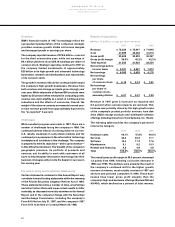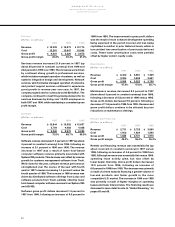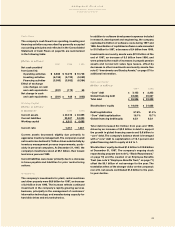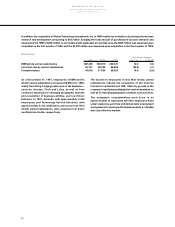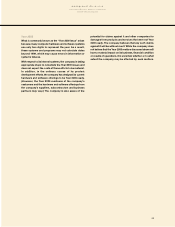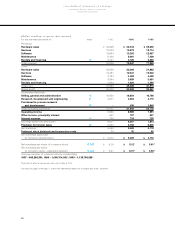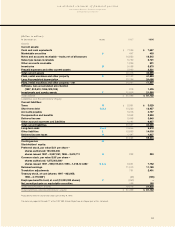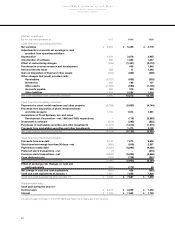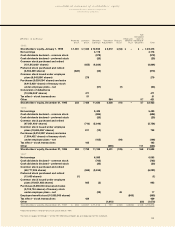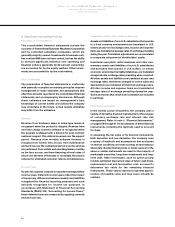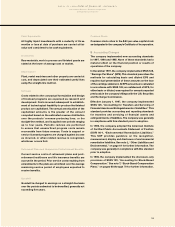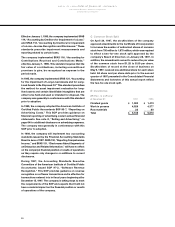IBM 1997 Annual Report Download - page 48
Download and view the complete annual report
Please find page 48 of the 1997 IBM annual report below. You can navigate through the pages in the report by either clicking on the pages listed below, or by using the keyword search tool below to find specific information within the annual report.
46
management discussion
International Business Machines Corporation
and Subsidiary Companies
Currency Rate Fluctuations
Since approximately 81 percent of the company’s non-
U.S. revenue was derived from affiliates operating in
local currency environments, the company’s results are
affected by changes in the relative values of non-U.S.
currencies to the U.S. dollar. Most worldwide currencies
weakened versus the U.S. dollar in 1997, which resulted
in assets and liabilities denominated in local currencies
being translated into fewer dollars. The currency rate
changes also resulted in an unfavorable impact on
revenue of approximately 5 percent and 3 percent,
respectively, in 1997 and 1996, compared to a favorable
impact in 1995 of 4 percent.
In high-inflation environments, primarily parts of Latin
America, translation adjustments are reflected in period
income, as required by SFAS 52, “Foreign Currency
Translation.” Generally, the company limits currency risk
in these countries by linking prices and contracts to U.S.
dollars, by financing operations locally and through foreign
currency hedge contracts.
The company uses a variety of financial hedging
instruments to limit specific currency risks related to
global financing transactions and the repatriation of
dividends and royalties. Further discussion on currency
and hedging appears in note J, “Financial Instruments,”
on pages 59 through 61.
Market Risk
In the normal course of business, the financial position
of the company is routinely subjected to a variety of
risks. In addition to the market risk associated with
interest and currency rate movements on outstanding
debt and non-U.S. dollar denominated assets and
liabilities, other examples of risk include collectibility of
accounts receivable and recoverability of residual values
on leased assets.
The company regularly assesses these risks and has
established policies and business practices to protect
against the adverse effects of these and other potential
exposures. As a result, the company does not anticipate
any material losses in these areas.
The company’s debt in support of the global financing
business (see note Q, “Global Financing,” on pages 65
and 66) and the geographic breadth of the company’s
operations contain an element of market risk from changes
in interest and currency rates. The company manages
this risk, in part, through the use of a variety of financial
instruments including derivatives, as explained in note J,
“Financial Instruments,” on pages 59 through 61.
For purposes of specific risk analysis, the company uses
sensitivity analysis to determine the impacts that market
risk exposures may have on the fair values of the
company’s debt and financial instruments.
The financial instruments included in the sensitivity
analysis consist of all of the company’s cash and cash
equivalents, marketable securities, long-term non-lease
receivables, investments, long-term and short-term debt
and all derivative financial instruments. Interest rate
swaps, interest rate options, foreign currency swaps,
forward contracts and foreign currency option contracts
constitute the company’s portfolio of derivative financial
instruments.
To perform sensitivity analysis, the company assesses
the risk of loss in fair values from the impact of
hypothetical changes in interest rates and foreign currency
exchange rates on market sensitive instruments. The
market values for interest and foreign currency exchange
risk are computed based on the present value of future
cash flows as impacted by the changes in the rates
attributable to the market risk being measured. The
discount rates used for the present value computations
were selected based on market interest and foreign
currency exchange rates in effect at December 31, 1997.
The market values that result from these computations
are compared with the market values of these financial
instruments at December 31, 1997. The differences in
this comparison are the hypothetical gains or losses
associated with each type of risk.
The results of the sensitivity analysis at December 31, 1997,
are as follows:
Interest Rate Risk:
A 10 percent decrease in the levels of interest rates with
all other variables held constant would result in a decrease
in the fair value of the company’s financial instruments by
$369 million. A 10 percent increase in the levels of interest
rates with all other variables held constant would result
in an increase in the fair value of the company’s financial
instruments by $341 million.
Foreign Currency Exchange Rate Risk:
A 10 percent movement in the levels of foreign currency
exchange rates against the U.S. dollar with all other
variables held constant would result in a decrease in the
fair value of the company’s financial instruments by
$809 million or an increase in the fair value of the
company’s financial instruments by $981 million.






